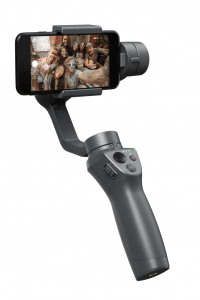There’s a time and place for a wide range of end products when it comes to corporate video production. Sometimes you need to bring in the big guns to help create a really professional final product, but in other cases quick and dirty video production can do just fine.
For most companies, a large-scale production isn’t necessary (or possible) for every type of shoot. And for lots of companies, the buy-in might not be there to fully invest in professional video equipment in-house. When these factors collide, you end up with the question that we’ve all heard: “Can’t we just shoot this on my iPhone?”
The question will make lots of people cringe, and for good reason. Even as camera quality continues to increase on smartphones with every new release, most footage shot directly from a phone isn’t going to be good enough to represent your brand publicly. But there are a few quick and relatively inexpensive steps you can take to transform your smartphone into a video production machine.
Sound Quality

We’ve talked before at length about the importance of audio in your online video content. One of the biggest elements that’s usually lacking in cell phone footage is anything resembling decent audio. Smartphones continue to ship with higher frame rates, larger sensors, and more features that can spice up your video. But no matter what, they’re still relying on a small internal microphone to capture sound.
The first thing you invest in for your smartphone video production kit should be a new microphone (or two). Rode makes a microphone specifically designed for interviews conducted via smartphone, and for $79 it’s not going to break your budget. For situations where you’re sitting down with more than one person, you might consider a shotgun mic like the Rode Videomicro instead. Just like the kit below, be sure to consider compatibility when buying.
Just like anything else, you can spend a lot more money on higher-quality microphones or wireless microphone kits. If you have extra room in your budget, a kit like the Sennheiser G3 Wireless Kit will give you flexibility and more quality. But beware of compatibility; professional mics like that kit often come equipped with a TRS jack, whereas smartphones work with TRRS jacks. Make sure you have the appropriate convertors, or your big investment will end in silence.
If you’re on a newer iPhone, you’ll also need to be sure that you’re ready to turn your lightning port into a TRS jack. You can buy the adapter directly from apple through their website.
Lighting Your Shots

Now that your audio is in order, it’s time to think about the picture itself. Smartphones are getting better all the time at shooting in low light thanks to better sensors and wider apertures. Still, smartphones often struggle to compensate for mixed lighting, and will leave your shot way too dark or completely blown out.
First and foremost, you should be looking to use natural light to your advantage. Whenever possible, don’t place your subject between you and a window. Find locations where light from the outside can illuminate your subject’s face and do the work for you.
Bringing in some help in the form of external lighting will go a long way. Even when you can use the sun to light your subject, you’ll contend with uneven light and shadows. Similar to the disclaimer on audio gear, there’s a wide range of equipment you can implement for lighting. This mini-kit from Neewer could be a good entry level option for folks with small budgets. A little bit more money could lead you to a kit like this Dracast kit, which is more powerful and allows you to adjust the color temperature of the light. Beyond that, there’s a whole world of much more effective (and expensive) lighting solutions that you can invest in. Chances are that if you’re looking to shoot on your smartphone, you might not be dipping your toe into that end of the pool.
Beyond using lights, you may also want to consider attaching an external lens like this kit from Aukey to help maximize your stock camera. You’ll be able to expand the field of view of your phone with a wide angle lens, and get better shots of b-roll up close with the macro attachment.
Stabilizing Your Video

Nobody wants to watch a corporate video that feels like the Blair Witch Project. No matter how steady you think your hands are, you won’t be able to hold your phone as still as a tripod will. Investing in a small tabletop tripod and a smartphone mount to go with it will keep you from making your audience seasick.
There are also options for folks who are on the move. The Osmo Mobile from DJI (a.k.a. the guys that make drones) is a must-have for people who want to move around while they shoot content. It allows you to shoot silky smooth motion on your phone, even when you’re walking around. This is great for people looking to walk through spaces or host Facebook Live Broadcasts in unpredictable circumstances.
Editing Your Final Product
It’s tough to get things right in one take. Even if your interviewee is a one-take wonder, you probably want to insert some b-roll to liven your video up. To do this, you’ll need to dive into some video editing.
The easiest solution here is iMovie for Apple users. Windows Movie Maker was a simple go-to for PC users, but since that’s been discontinued many have turned to ShotCut for simple projects. TechRadar has a great breakdown of some free video editing software of ranging complexity that can help you get started.
If you feel like you’ve graduated from the free products, the next step would be to look into a product like Adobe Premiere. Premiere is now a subscription-based product, but you can pay monthly if you’d like to try it out without a commitment.
Up Your Smartphone Video Production Game
If the best way for you to produce content for your business at scale is with your smartphone, then so be it. Just make sure to start taking steps to make this content as professional as possible. Start small, and add components piece by piece if necessary. In a world in which it’s harder than ever to get in front of your audience, it’s critical that the content you’re publishing is high quality.


hey awesome post